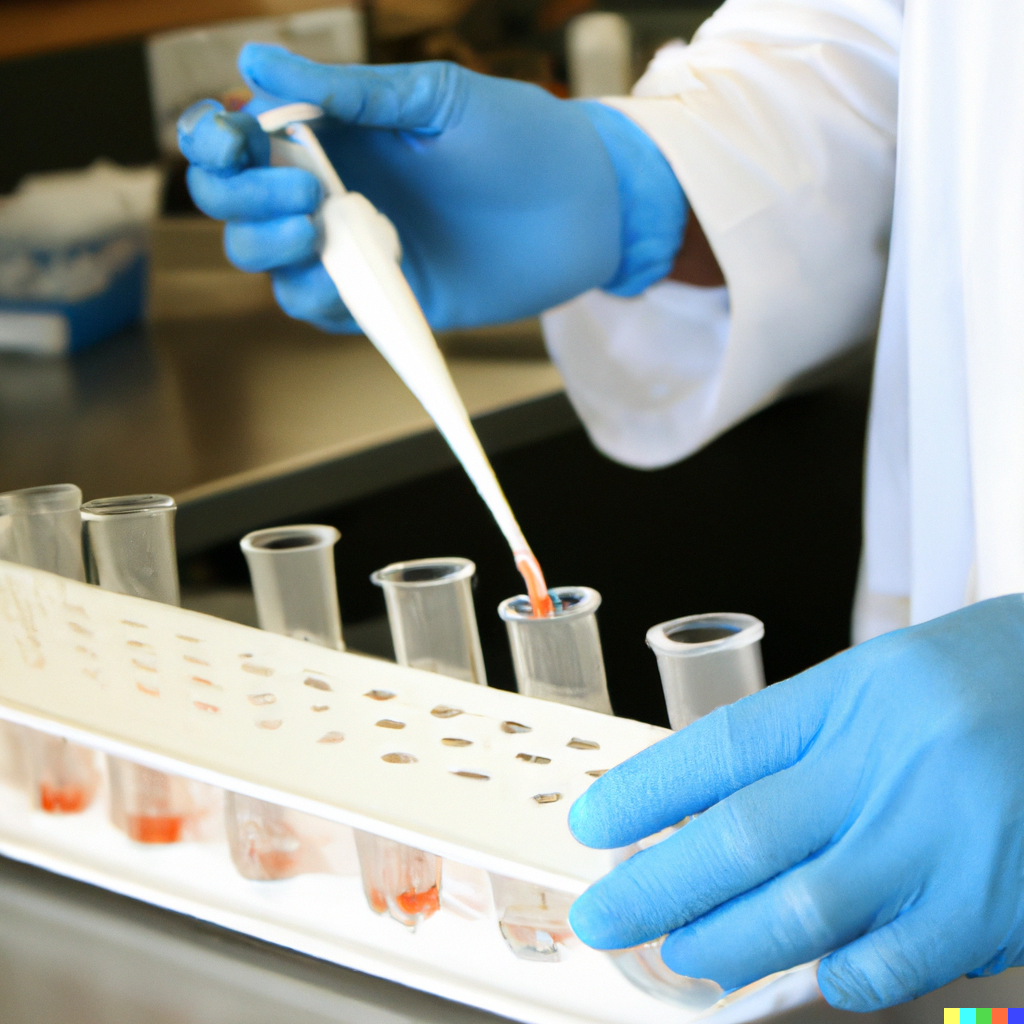Available Technologies
# of Displayed Technologies: 17 / 17
Applied Category Filter (Click To Remove): Clinical Area
Dual-payload Humanized Antibody-Drug Conjugate (DualADC) for targeted chemo-immunotherapy
TS-062822 — Humanized Antibody-drugs conjugate for chemo-immunotherapy of multiple cancer types
The Technology
Dr. Margaret Liu and colleagues have developed a dual-payload antibody-drug conjugate (DualADC) for chemo-immunotherapy utilizing a new humanized antibody that targets CD276, a surface receptor that is overexpressed in Triple-negative Breast Cancers (TNBCs), lung cancer (including non…
- College: College of Engineering (COE)
- Inventors: Liu, Xiaoguang "Margaret"; Zhou, Lufang
- Licensing Officer: Schworer, Adam
 Dual Androgen Receptor/AKR1C3 Inhibitors for Prostate Cancer
Dual Androgen Receptor/AKR1C3 Inhibitors for Prostate Cancer
TS-062605 — The Need:
Castration-resistant prostate cancer (CRPC) poses a significant challenge in oncology, with existing therapies often leading to resistance and disease progression. Key drivers of resistance include the androgen receptor (AR) and aldo-keto reductase family 1 member C3 (AKR1C3). Novel treat…
- College: College of Pharmacy
- Inventors: Li, Pui-Kai "Tom"; Cheng, Xiaolin; Kong, Xiaotian; Xing, Enming
- Licensing Officer: Schworer, Adam
Purification of apoproteins and general methods for protein purification
TS-062540 — General methods for purifying proteins that can be used in various applications such as targeted drug delivery, bioimaging, and hemolysis treatment.
The Need
Novel protein and apoprotein purification strategies are valuable tools with a wide variety of medical and research applications. While there are existing techniques for protein and apoprotein purification, some of these have flaws such as the use of harsh denaturants, highly flammable sol…
- College: College of Engineering (COE)
- Inventors: Susin Pires, Ivan; Cabrales, Pedro; Palmer, Andre
- Licensing Officer: Schworer, Adam
Rabbit Model for Duchenne Muscular Dystrophy
TS-058084 — A rabbit model has been created for Duchenne Muscular Dystrophy (DMD) that more closely resembles the effects experienced in humans while being more cost effective compared to larger animal models.
There has yet to be a DMD animal model that bridges the gap between cost effectiveness and scientific relevance. This new rabbit model does that.
DMD is a lethal genetic disease characterized by progressive muscle weakness and muscle wasting. There are several animal models for DMD, includin…
- College: College of Medicine (COM)
- Inventors: Han, Renzhi
- Licensing Officer: Schworer, Adam
A novel mouse model of spontaneous chronic lymphocytic leukemia
TS-055268 — The laboratory of Dr. Rosa Lapalombella in collaboration with Dr. James Blachly at The Ohio State University has developed a mouse model of spontaneous Chronic Lymphocytic Leukemia.
The Need
Chronic lymphocytic leukemia (CLL) accounts for one quarter of new cases of leukemia. CLL is the most prevalent adult leukemia in Western countries and is characterized by a mature B-cell phenotype. Given the burden of this disease, a large pipeline of drugs for treatment are in progress…
- College: College of Medicine (COM)
- Inventors: Lapalombella, Rosa; Blachly, James; Byrd, John
- Licensing Officer: Schworer, Adam
Therapeutic uses of the scavenging protein cocktail to treat plasma protein imbalances or depletion
TS-053103 — Uncontrolled hemolysis (i.e., destruction of red blood cells) is characterized by the increase of circulating toxic cell-free hemoglobin, heme and iron in the bloodstream. In vivo, the body’s natural supply of plasma scavenger proteins acts to neutralize these toxic species. However, these scavenger proteins such as haptoglobin, hemopexin and transferrin, which detoxify hemoglobin, heme and iron, respectively, are depleted in various clinical conditions such as hemorrhagic shock, burns, surgery, organ transplantation, sepsis and trauma.
Dr. Andre Palmer’s lab at The Ohio State University has developed a novel therapeutic protein mixture, which can be used to treat plasma protein imbalances or depletion caused by the adverse events described above. The properties of this protein mixture are beneficial as they lend themselves to an inexpensive manufacturing process and potential improvements in clinical outcomes.
Fluid replacement as part of resuscitation efforts in clinical care is a cornerstone of treatment especially in cases with severe trauma. The regular usage of these fluids in hospitals requires the mixture to be easily transported, easily stored and applicable across a wide variety of patients. To…
- College: College of Engineering (COE)
- Inventors: Susin Pires, Ivan; Palmer, Andre
- Licensing Officer: Schworer, Adam
 SARS-CoV-2 Diagnostic Assay with Sensors of Immune Activation
SARS-CoV-2 Diagnostic Assay with Sensors of Immune Activation
TS-050296 — A sequencing-based diagnostic assay for SARS-CoV-2 with sensors of immune activation and the viral microbiota.
Diagnosis of SARS-CoV-2 infection, which is responsible for COVID-19 disease, is typically performed by molecular analysis of upper respiratory sampling (e.g. nasal swab). Transcriptional-mediated amplification (TMA) and quantitative (real-time) polymerase chain reaction (qPCR) using one or more v…
- College: College of Medicine (COM)
- Inventors: Jones, Daniel; Avenarius, Matthew; Tu, Huolin
- Licensing Officer: Schworer, Adam
An improved base editor (iABE-NG) for correcting genetic diseases such as Duchenne muscular dystrophy
TS-049505 — An engineered base editor (iABE-NG) that uses an SpCas9 variant, a shortened adenine deaminase domain with eliminated RNA off-target activity, and an intein split for packaging into an adeno-associated virus (AAV), resulting in gene mutation correction.
There are thousands of monogenic diseases that are lacking effective therapeutic treatments. The main bottleneck in developing effective treatment is the ability to effectively edit gene while controlling for the myriad of off-target effects that come with targeting the genome. Duchenne Muscular D…
- College: College of Medicine (COM)
- Inventors: Han, Renzhi; Gao, Yandi; Xu, Li
- Licensing Officer: Schworer, Adam
Biomimetic vitreous substitute with ocular drug delivery
TS-044490 — Methods and compositions for an antioxidant releasing hydrogel vitreous substitute
The vitreous humor is a fragile, transparent tissue between the lens and the retina of the eye that maintains the shape of the eye, acts as a shock absorber, and enables nutrient diffusion to ocular tissues. The vitreous also plays a key role in oxygen homeostasis. Over time, the vitreous degrades…
- College: College of Engineering (COE)
- Inventors: Reilly, Katelyn; Reilly, Matthew; Tram, Nguyen "Archie"
- Licensing Officer: Schworer, Adam
Translational Activators of the Glutamate Transporter EAAT2 to Treat Neurological and Psychiatric Diseases
TS-043938 — Small molecule technology with novel translational activation mechanism.
Glutamate is a major neurotransmitter in the mammalian central nervous system (CNS) and essential for normal brain function including cognition, memory, and learning. However, the extracellular concentration of glutamate must remain below excitotoxic levels (~ 1 μM) to avoid overstimulation of …
- College: College of Medicine (COM)
- Inventors: Lin, Chien-Liang
- Licensing Officer: Schworer, Adam
High-strength and Corrosion Resistant Alloy for Patient-Specific Bioresorbable Bone Fixation Hardware
TS-042526 — Novel ternary and quaternary Mg-Zn-Ca-based alloys and a heat treatment process for producing bioresorbable bone fixation implants with improved mechanical and corrosion properties
Mg-Zn-Ca-based alloys are the most promising alloy system for bone implant applications mainly due to their superior biocompatibility. For fixation applications, the ideal is a material strong enough to hold while healing (2-4 months) yet being fully resorbed after the bones have healed (6-24 mont…
- College: College of Medicine (COM)
- Inventors: Dean, David; Elahinia, Mohammad; Ibrahim, Hamdy
- Licensing Officer: Schworer, Adam
Sustained Release Microparticles for the Treatment of Ocular Diseases
TS-038312 — A novel, intravitreal microparticle injection capable of controlled-release of protein therapies (including anti-VEGF) for tunable periods of 6-12 months after injection for the treatment of age-related macular degeneration.
Age-related macular degeneration (AMD) is the leading cause of blindness in individuals 65 and older and is the third leading cause of blindness worldwide. Wet AMD is characterized by abnormal growth of leaky blood vessels leading to damage to the macula of the retina resulting in vision loss and …
- College: College of Engineering (COE)
- Inventors: Jiang, Pengfei; Ohr, Matthew; Reilly, Katelyn
- Licensing Officer: Schworer, Adam
RNA Sequencing Assay to Detect Gene Fusion Mutations that Occur in Multiple Cancer Types
TS-038065 — OSU-SpARKFUSE is an RNA sequencing assay that detects known and novel gene fusion mutations in multiple cancer types.
Chromosomal rearrangements, leading to the juxtaposition of two unrelated genes and thus creating a chimeric mRNA transcript and protein ("gene fusions"), are important drivers of abnormal cell growth in cancers. Although gene fusions have a well-established role in hematologic malignanc…
- College: College of Medicine (COM)
- Inventors: Roychowdhury, Sameek
- Licensing Officer: Schworer, Adam
 Targeted molecules for the treatment of cancer
Targeted molecules for the treatment of cancer
TS-038027 — Novel dihdroorotate dehydrogenase (DHODH) small-molecule inhibitors for the treatment of Acute Myeloid Leukemia, Multiple Myeloma, & Graft vs. Host Disease / Leukemia.
DHODH is a rate-limiting enzyme in de novo pyrimidine synthesis. Rapidly dividing cancer cells are therefore sensitive to blockade of this pathway. New research has shown DHODH inhibition can induce differentiation in acute myeloid leukemia (AML) cell lines, translating to increased survival in an…
- College: College of Medicine (COM)
- Inventors: Byrd, John; Abdulrahim, Mouad; Elgamal, Ola; Goodwin, Thomas; Hertlein, Erin; Ravikumar, Pratheepa; Shah, Dimple
- Licensing Officer: Schworer, Adam
Six Degrees-of-Freedom Quality Assurance Phantom for Radiation Therapy Linear Accelerators
TS-037968 — The medical physics group in the Department of Radiation Oncology has devised a 6DoF phantom that is the first of its kind to fully integrate multiple routine QA tests specifically for a six degrees-of-freedom linac table.
6DoF treatment tables allow for 2 additional degrees (pitch and roll) compared to traditional 4DoF (vertical, lateral, longitudinal, and yaw) when correcting for patient setup during image-guidance prior to treatment delivery. These tables allow for more accurate patient treatments and could poten…
- College: OSU Wexner Medical Center
- Inventors: Woods, Kyle; Ayan, Ahmet; Gupta, Nilendu; Woollard, Jeffrey
- Licensing Officer: Schworer, Adam
miRNA-based Predictive Model for Biochemical Failure Following Post-Prostatectomy Salvage Radiation Therapy
TS-037521 — A method to use MiRNA to predict the likelihood of biochemical failure after radiation surgery.
The Need
Prostate cancer is one of the most common cancers worldwide, but current treatments can sometimes lead to complications. For example, radical prostatectomy is widely used for men in the early stages of prostate cancer, but long-term data shows that 30-40% of these patients experience bioch…
- College: College of Medicine (COM)
- Inventors: Chakravarti, Arnab; Bell, Erica
- Licensing Officer: Schworer, Adam
miR-3151 and BAALC as a Target for Drug Therapy
TS-014895 — Identified gene target for treatment of human acute leukemia, brain tumors and melanoma
Treatment failure is one of the leading causes of death in patients with human acute leukemia, yet the cause of treatment failure is still largely unknown. Overexpression of the RNA gene miR-3151 and its host gene, Brain and Acute Leukemia, Cytplasmic (BAALC), is a sign of an ineffective treatment…
- College: College of Medicine (COM)
- Inventors: de la Chapelle, Albert; Eisfeld, Ann-Kathrin; Tanner, Stephan
- Licensing Officer: Schworer, Adam
